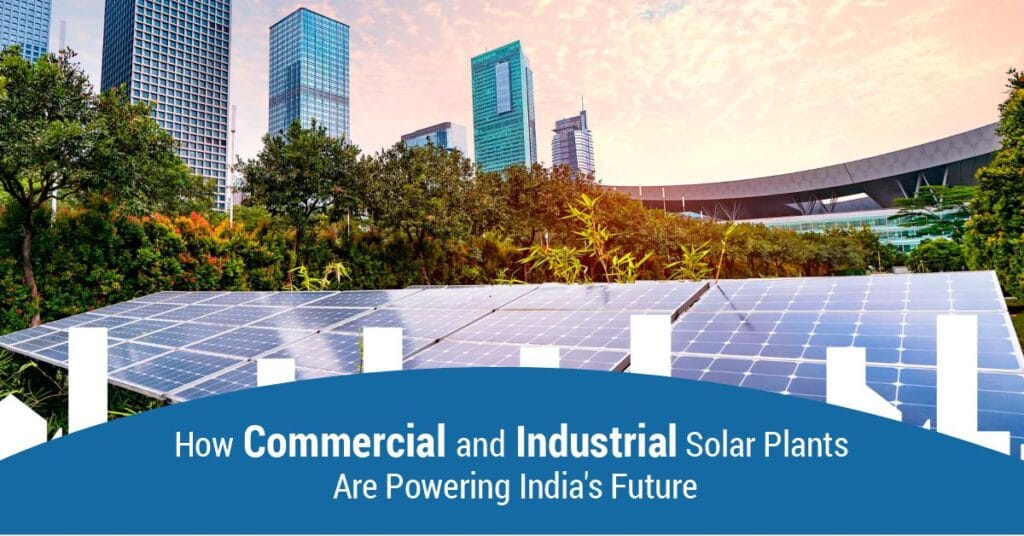
Residential Solar Plants: A Smarter, Cleaner Energy Choice with Sunpure Energy
In a world racing toward sustainability, renewable energy isn’t just

In the quiet, dusty outskirts of a mid-sized town in Gujarat, a revolution is unfolding—not with protests or parades, but with panels. Hundreds of solar panels, aligned in perfect geometric harmony, shimmer under the harsh Indian sun. This isn’t just another infrastructure project; it’s the heartbeat of a factory that no longer depends on coal or diesel to keep its wheels spinning.
This is the face of the new India—one where Commercial And Industrial Solar Plants (C&I) solar plants are not only transforming how businesses operate but also powering a more sustainable future for the nation.
India is one of the fastest-growing economies in the world. With industrialization booming and urbanization expanding at breakneck speed, the demand for energy has shot through the roof. Traditional power sources—coal, gas, and hydro—are not only limited but also environmentally taxing.
Enter solar energy.
For a country blessed with over 300 sunny days a year, solar power has become an obvious and promising solution. And while residential solar systems are gaining popularity, it is the commercial and industrial sector that is driving the most significant adoption.
There’s a simple reason: economics.
Electricity is a significant operational cost for industries and commercial establishments like factories, warehouses, IT parks, hospitals, malls, and cold storages. With tariffs rising and grid reliability fluctuating in some parts of India, solar power offers a cleaner, cheaper, and more consistent alternative.
Companies that switch to solar can cut electricity costs by up to 40–60%, depending on the size and usage pattern. And with government incentives, depreciation benefits, and declining solar installation costs, the return on investment is becoming increasingly attractive.
Commercial and industrial solar installations typically come in two forms: on-site (captive) and off-site (open access) systems.
On-site solar systems involve setting up solar panels on the premises—on rooftops, car parks, or adjacent land.
Open access systems allow businesses to purchase solar power generated at remote solar farms through the electricity grid, often at cheaper rates than the local utility.
Advanced metering systems, remote monitoring, AI-driven performance analytics, and battery storage (in some cases) ensure seamless integration into the business’s existing infrastructure.
India’s government has been instrumental in pushing for solar adoption through favorable policies and initiatives like:
Accelerated depreciation for solar assets
Subsidies and incentives through state-level solar policies
Net and gross metering mechanisms for rooftop solar
Renewable Purchase Obligation (RPO), mandating certain industries to source a percentage of their power from renewables
These policies have made it easier for C&I players to take the solar plunge without facing regulatory roadblocks.
One of South India’s largest textile mills recently invested in a 5 MW captive solar plant. Their electricity bills have reduced by more than 50%, and the plant pays for itself in just under five years. The management proudly claims they now manufacture eco-friendly clothing not just in terms of material, but also energy source.
A cold storage chain in Punjab with energy-intensive refrigeration needs switched to an open-access solar model. Not only did they reduce costs, but they also ensured 24×7 power backup without depending on diesel generators—reducing both expenses and carbon footprint.
Several tech parks in Bangalore are adopting rooftop solar solutions. With buildings that operate round-the-clock, energy savings are massive. They are also leveraging green credentials to attract top-tier tenants who care about sustainability.
The significance of C&I solar plants goes beyond just business gains. They are at the heart of India’s strategy to combat climate change and meet its Net Zero goals by 2070. Each megawatt of solar installed can reduce approximately 1,200–1,500 tons of CO₂ emissions annually.
Imagine the cumulative impact when thousands of commercial establishments embrace solar. It’s not just electricity—it’s cleaner air, healthier communities, and a planet worth inheriting.
While the benefits are evident, designing, installing, and maintaining a commercial solar plant is a complex task. This is where expert solar solution providers like Sunpure Energy play a vital role.
From feasibility studies and load analysis to EPC (Engineering, Procurement, and Construction) services and remote monitoring—Sunpure Energy delivers turnkey solutions tailored to business needs. With a focus on quality, compliance, and long-term performance, they ensure businesses enjoy a seamless solar journey.
Despite the promise, there are challenges:
Initial capital investment remains a deterrent for some MSMEs.
Land availability for ground-mounted systems can be a concern in urban zones.
Regulatory bottlenecks and DISCOM approval delays can slow down implementation.
Awareness gaps—many businesses still lack clarity on the long-term financial and operational benefits.
However, with innovations like solar leasing, power purchase agreements (PPAs), and green financing, these obstacles are steadily being addressed.
The future looks bright—literally.
India is targeting 500 GW of non-fossil fuel capacity by 2030, with solar playing the lead role. The commercial and industrial sectors are expected to contribute a significant chunk to this ambition.
With rising environmental awareness, supportive policies, and a maturing solar ecosystem, C&I solar plants will continue to expand—powering not just factories, malls, and offices, but an entire nation’s dreams of green growth.
Conclusion: A Bright Business Move That Powers a Nation
India’s path to sustainable development runs through its factories, warehouses, hospitals, and office towers. By embracing solar, commercial and industrial players aren’t just making a smart financial move—they’re becoming partners in the nation’s clean energy mission.
As panels continue to rise across the country’s rooftops and landscapes, one thing is clear: the sun isn’t just shining—it’s powering India’s future.

In a world racing toward sustainability, renewable energy isn’t just
In a world racing toward sustainability, renewable energy isn’t just